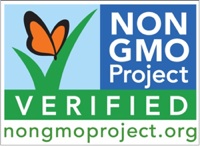
         |
Say No to GMOs
By Melissa Diane Smith
Why you don't want genetically modified organisms – hidden in everyday foods – and how to avoid them.
Imagine engineers manipulating common food crops and making them produce their own insecticide or making them resistant to chemical herbicides that kill other plants. These sound like scenarios that you might see in a scary futuristic sci-fi movie, yet they have already happened and many of us are unknowingly eating foods that are genetically modified in one of these ways – or both of them – every day.
In genetic engineering, genes from bacteria, viruses, animals and other sources are inserted into plants (and animals such as salmon that are not yet in our food supply) to create a genetically modified organism (GMO) that would never occur in nature. Despite warnings of health dangers from its own scientists, the U.S. Food and Drug Administration decided to allow genetically modified (GM) foods on the market without labeling and without safety testing, and commercial planting of these never-before-used seeds began in 1996. Now most of the four major GM foods – soybeans, corn, canola, and cotton – are genetically modified. According to the USDA, 93 percent of all soybeans, 78 percent of all cotton, and 70 percent of all corn grown in the United States in 2010 were genetically modified to be herbicide tolerant. Some GM foods, such as corn, are increasingly "stacked" – genetically modified to be both herbicide tolerant and insect resistant. It's estimated that most Americans, including many health food shoppers, are eating GM foods without realizing it because the most common GM foods like soy and corn are in most convenience foods and GM foods are not labeled. In other countries, GM foods are labeled or they're banned.
The Health Risks of GMOs
What you didn't know you've been eating may be harming you. Based on animal research with GM foods, the American Academy of Environmental Medicine (AAEM), an international organization of physicians, says that there are serious health risks associated with eating GM foods, including infertility, immune system problems, accelerated aging, disruption of insulin and cholesterol regulation, gastrointestinal problems, and organ damage. "There is more than a casual association between GM foods and adverse health effects. There is causation," as defined by recognized scientific criteria, the academy concludes. In 2009, the AAEM called for a moratorium on GM foods and urged doctors to prescribe non-GMO diets for all patients. Some AAEM physicians say that doctors are probably seeing negative health effects in their patients right now from GM foods but not realizing that GM foods are major contributors to various health conditions.
Scientific research and reports from farmers around the world have linked GM foods to thousands of sick, sterile and dead livestock, thousands of toxic and allergic reactions in humans, and damage to virtually every organ studied, says Jeffrey M. Smith, a leading non-GMO advocate and author of Genetic Roulette.
In the area of reproduction, male rats fed GM soy had changes in the structures and function of their testicles which influenced sperm development. When female rats were fed GM soy before they conceived and through pregnancy and lactation, more than 50% of their offspring died within 3 weeks compared to only 10% of those whose mothers ate non-GM soy.
In terms of changes to organs, a 2009 study found that three types of GM corn that have been approved for human consumption were linked to damage to the kidneys and liver as well as changes to the heart, adrenal, spleen and blood cells in rats who ate the corn for just 90 days.
As far back as 1996, a study in the New England Journal of Medicine found that an allergen from a food known to be allergenic can be transferred into another food, in this case soy, by genetic engineering. That version of GM soy was not brought to market but other types of GM soy have been. Soon after GM soy was introduced, the incidence of soy allergies increased by 50% in the United Kingdom and reported symptoms related to the soy allergies included irritable bowel syndrome, other digestive problems, and skin conditions such as eczema. GM soy may be more likely to provoke allergies for several different reasons, Smith says. Cooked GM soy has seven times more trypsin inhibitor, a known soy allergen, than cooked non-GM soy. GM soy also has higher levels of herbicide residues, which might trigger reactions, and preliminary research suggests it contains a new potential allergen not found in non-GM soy.
The one and only published GM study on humans revealed that in some people, herbicide-resistant genes from soybeans transfer into the DNA of bacteria living inside the intestines – and continue to function. "This means that long after we stop eating GMOs, we may still have potentially dangerous GM proteins continuously produced inside of us," Smith says.
No Benefits, Just Risks
Proponents of genetic engineering say it can increase crop yield and reduce pesticide use. But research says otherwise. Despite twenty years of research and thirteen years of commercialization, genetic engineering has failed to significantly increase U.S. crop yields, according to a 2009 Union of Concerned Scientists report. And pesticide use has actually dramatically increased – about 318 million pounds – in the last thirteen years as a result of planting GM crops, according to a 2009 report by the Organic Center. One of the most serious environmental threats is of GM seeds spreading to and contaminating non-GMO crop fields.
The Center for Food Safety, a non-profit public interest and environmental advocacy group that challenges harmful food production technologies and promotes sustainable alternatives, calls the U.S. regulation of genetic engineering "haphazard and negligent" and "a disaster for consumers and the environment." It says now is a critical time to challenge the government's negligence.
The Power to Change Things
Here's the good news: Natural food shoppers have the power to get GM foods out of the market or at least minimized and labeled so we can more easily avoid them, says Smith, who is also the executive director of the Institute for Responsible Technology.
When as little as 5% of the population are vigilant about avoiding genetically modified foods when they grocery shop, it can create a tipping point – a moment when major food companies realize that using GMOs is a liability in foods and they start pulling GM ingredients from their products, Smith says.
"The tipping point came very swiftly – within a single week – in the EU (European Union)," in 1999, Smith says. "We expect a similar tipping point here in the U.S. It may not come quite within a single week, but the numbers of people who buy organic foods and shop for specialty health foods is more than sufficient to bring about that tipping point."
So, just by being educated about how to avoid GMOs and shopping with non-GMO savvy, "together we can reclaim safe food for our health and the health of future generations," Smith says.
How to Say No to GMOs
Tip #1: Buy Organic
Certified organic products cannot intentionally include any GMO ingredients. Buy products labeled "100% organic," "organic," or "made with organic ingredients." You can be doubly sure if the product also has a Non-GMO Project Verified Seal.
Tip #2: Look for Non-GMO Project Seals
Products that carry the Non-GMO Project Seal are independently verified to be in compliance with North America's only third party standard for GMO avoidance, including testing of at-risk ingredients.
Tip #3: Avoid at-risk ingredients
If it's not labeled organic or verified non-GMO, avoid products made with ingredients that might be derived from GMOs. The eight GM food crops are:
- Corn (as in corn oil, cornmeal, cornstarch and other corn-based ingredients)
- Soybeans (as in soybean oil, soy protein, soy lecithin, soy milk, tofu, and other soy-based ingredients)
- Canola (as in canola oil)
- Cottonseed (as in cottonseed oil)
- Sugar Beets* (as in "sugar" in an ingredient)
* GM sugar beets have been introduced into our food supply but are involved in legal challenges that could take them off the GMO list. If they are not taken off the list, read labels and understand that if a non-organic product made in North American lists "sugar" as an ingredient (as opposed to pure cane sugar or evaporated cane juice), then it is almost certainly a combination of sugar from both sugar cane and GM sugar beets.- Most Hawaiian Papaya
- A small amount of Zucchini and Yellow Squash
Also, beware of Dairy Products, which may be from cows injected with GM bovine growth hormone. Look for dairy products labeled "No rBGH or rBST," or "artificial hormone-free."
Tip #4: Use non-GMO Shopping Guides
Download either the new Non-GMO Shopping Tips brochure or redesigned Non-GMO Shopping Guide at www.nongmoshoppingguide.com to help you identify and avoid GM foods and hidden GM ingredients on food labels. If you have an iPhone, download the ShopNoGMO guide for free from the iTunes store.
Source: Non-GMO Shopping Guide, www.nongmoshoppingguide.com, by the Institute for Responsible Technology
 |
© Copyright 2002 -
All rights reserved. Reproduction of material without written permission is strictly prohibited.
